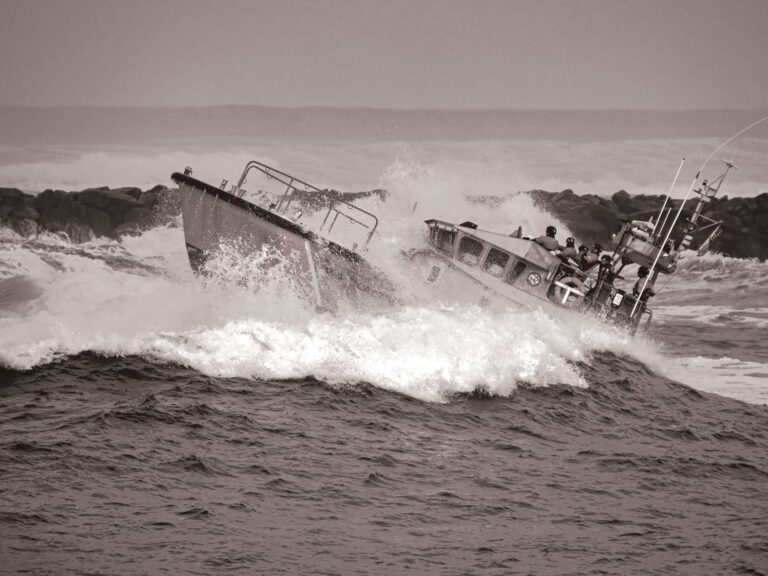Unlike a Ford Taurus or an Amana dishwasher, the boat you own and each one you dream about are more than likely the expression of one man. Boats are simple in that way. They’re not designed by committees or departments, and we love them for that. It’s what gives them their character and personality. One man, one vision. But who are the guys with a vision? We call them “game changers,” the designers coming up with ideas that others will eventually copy.
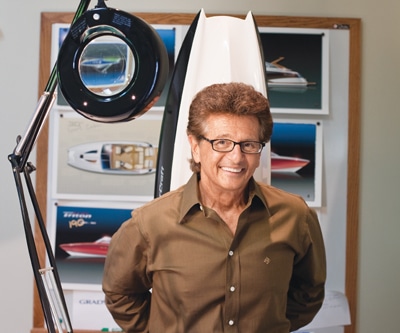
Peter Granata
Today’s boats are important; they’re tomorrow’s memories.
Lives in: Hilton Head, South Carolina
Sketch: Taking his name from his father, a U.S. senator, Junior was expected to continue the family’s political tradition but decided it was more fun to play with boats. He also bikes 15 miles a day.
Peter Granata doesn’t make boats faster, stronger or more efficient. Instead, he makes them easier to connect with. Think of him as a marine matchmaker, bringing boats and people together. Granata deals with emotions, and that’s critical because — let’s face it — no one needs a boat. We buy them because they stir something in us, and Granata supplies the “something.”
Trained as an industrial designer, he started in the automotive industry and, through quirks of life, wound up in boats. When asked how he approaches his work, his reply is simple. “I listen,” he says. He calls it murmur research.
One of his boats that gave us what we wanted was the 1991 Cobalt 22 Tradition. It began the retro look, especially Granata’s signature reverse transom, which was picked up by others. With Cobalt he also popularized forward-facing lounges in bow cockpits, so you no longer had to sit bolt upright with back to gunwale. A simple idea, but someone had to think of it first.
Recently he’s won acclaim for his MasterCraft concept boat, the X-trek. No one had ever seen anything like it before. But now you do, as other builders are lifting elements of the design. Probably the most copied feature has been the broad bow, which gives more interior room forward on a V-hull. Granata not only made it work but made it look beautiful as well. Then there are the boat’s dashboard, seats, top and…well, you’ll soon see it all on other boats. But by then Granata will be on to something new for us.
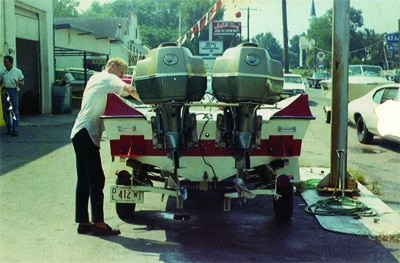
Paul and Darris Allison
First to be fast, fast to be first
Live in: Louisville, Tennessee
Sketch: Paul’s grandfather owned a steamboat line on the Tennessee River, and his family lived on the boats, so boating really is in the bloodlines.
At the 50th anniversary of Allison Boats there was a replica of the company’s first model from 1955 — and it had a stepped hull! Which should give you a clue as to whom we’re dealing with here.
I’m not sure how the Allison’s, builders of some of the fastest bass boats in the world, have done it. Paul (now in his mid- 80s) and his son Darris have laid claim to an amazing list of firsts.
There’s cupping prop blades, which involves putting a small curl on the trailing edge to reduce cavitation and slippage. Also there are streamlined gear cases to increase speed and reduce blowout. One of their most notable advances was the keel pad. It forever changed bass boat hulls. By making the keel a long, narrow, flat surface instead of a sharp edge, a boat would rise up higher and go faster — without sacrificing a V-bottom’s smooth ride.
To complement this in 1974, the Allison’s came up with the setback, or “notched” transom. This notch moved the transom forward where the water cleared it, giving the prop more leverage for steering, trim and speed.
The Allison’s were early adapters of all-composite construction, built-in tackle boxes, trim switches on the wheel and quick-change windshields, and the list goes on and on. To be fair, boatbuilding is a small copycat industry. Ideas get shared and picked up. We know that others also take claim for some of the above. But no family has done so much, for so long.
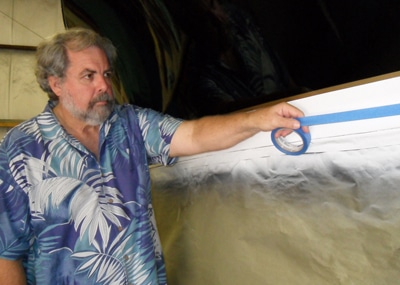
Michael Peters
Something between an engineer and an artist
Lives in: Sarasota, Florida
Sketch: He won academic acclaim for one of his boats from the Chicago Athenaeum: Museum of Architecture and Design in company with the Mini Cooper and iPod.
Imagine being in back of a college engineering class drawing boats instead of taking notes. Being obsessed with go-fasts and having Don Aronow as your hero. And imagine that a prototype of your boat — the first deep-V with steps — gets made by one of the big-name builders and Aronow himself is coming down to give it his blessing. And imagine that after the ride your hero turns to you, and he says, “Don’t waste your time, kid.”
Well, Michael Peters didn’t give up and start selling vacuum cleaners. “I filed the plans away for 10 years,” he says, “and got on designing other boats.”
Then, in 1991, Intrepid called, looking for something “new.” Out came Peters’ old plans for that 38-footer, which would begin the stepped-hull craze. The boat was fast, but it didn’t spin out in turns, unlike those boats from other designers who followed Peters’ lead.
Peters has made a name for being the go-to guy if you wanted to win races. His boats have dominated Offshore Class 1 since 1991, winning a record 13 world championships, including a sweep from 2000 to 2008. He’s done work for Cigarette, Magnum, Invincible and others. But his most recent breakthrough boats had nothing to do with speed.
In OMC’s waning days, during the late 1990s, it wanted to revive Chris-Craft’s past glories. Corporate heads had seen Peters’ remarkable Alpha–Z and gave him carte blanche to remake the Chris-Craft. The result was the launch, an instant classic that evoked memories while establishing a future.
“It’s my dear-old-dad boat,” Peters says, “something you think you remember from growing up.” It worked, proving that what once worked so well can work again, only better, in the right hands.
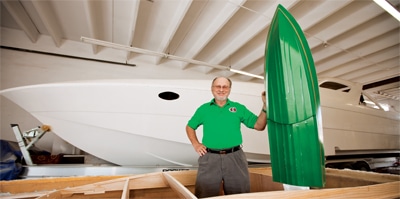
Harry Schoell
Too many ideas, not enough time
Lives in: Pompano beach, Florida
Sketch: By 16 he was doing the design work for his father’s boatbuilding business. Harry planned to go to the University of Miami, but his heart was in boats, so that’s where he stayed.
A long time ago, after seeing Back to the Future, I joked that if I were ever stuck in the space-time continuum and needed a Mr. Fusion Home Energy Reactor that used garbage to power my boat’s flux capacitor, Harry Schoell would probably be able to build me one. That was in 1985, and I’d still call him today. For more years than he likes to admit, Schoell has been boating’s never-ending source of new ideas.
He’s best known for his delta conic hull, which, unless you’re told otherwise, looks like a typical modified-V with its steep deadrise forward gradually flattening aft. But there are nuances. The bow is a section of a cone (the “conic” part), which blends into an aft bottom with lines that spread out in a smooth V (the “delta” part). The more visible feature is the wide down-turned chines, which provide stability and hold down the spray. Larson Boats has used this shape for decades, and others have mimicked it.
There’s also Schoell’s version of the stepped hull, which he calls the Duo Delta Conic (if nothing else, he comes up with cool names). But that’s nothing compared with his Infinity Motoryachts from the 1980s. He called them his “McDonald’s boats” because they had twin arches that supported a giant sail for downwind cruising.
And about building a Mr. Fusion, well, it’s no joke. He’s made one. Or something like it.
“It can run on orange peels, algae and fryer grease, as well as fossil fuels,” he claims. It’s a refinement of what is known as a Rankine engine, used in electric power plants. Schoell calls it Cyclone Power and is making 5 hp to 330 hp models for boats. Or a Delorean. Your pick.
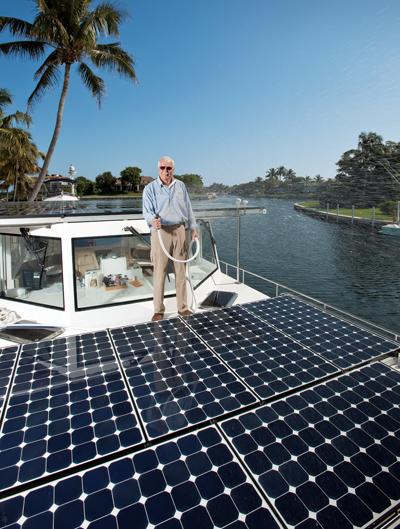
Reuben Trane
Let’s try it and see what happens.
Lives in: Key largo, Florida
Sketch: Trane’s great-grandfather founded the company that might have made your air conditioner. Reuben also won an award for creating Manhattan Melody, a comedy about a bicycle thief.
You’ve heard the expression “thinking outside of the box.” Well, Trane is the kind of guy who doesn’t even acknowledge there is a box. He looks at boats and boating with an eye unhindered by what should be.
“I think of the kind of boats I’d like,” he once told me, “and build them for everyone else.” Not everyone thinks like Trane.
He came out of Columbia University with a Master of Fine arts, got into filmmaking and then made a quick and unlikely transition into boatbuilding. His first foray was an odd collection of slab-sided sailboats. He then turned to power. Wanting a floating home for himself, he came up with the Florida Bay Coasters, a range of steel “personal freighters” that had the comfort of a condo with the salty looks of a tramp steamer. The Coasters even came with their own jeeps that could be hoisted on board with a crane.
There’s also been a series of trawler types, culminating in his recent Island Pilot series. But now he’s taken on the biggest leap yet — into the future, with the DSe Hybrid. When fuel prices went through the roof in 2006, he wanted the most fuel-efficient boat possible and thought others would too. His radical solution uses solar panels with a diesel/electric system on catamaran hulls more suited to sailboats for the lowest possible drag at 10 mph. As with all of Trane’s boats, its looks are…well, let’s say it’s an acquired taste. But it has an undeniable character, like Trane himself.
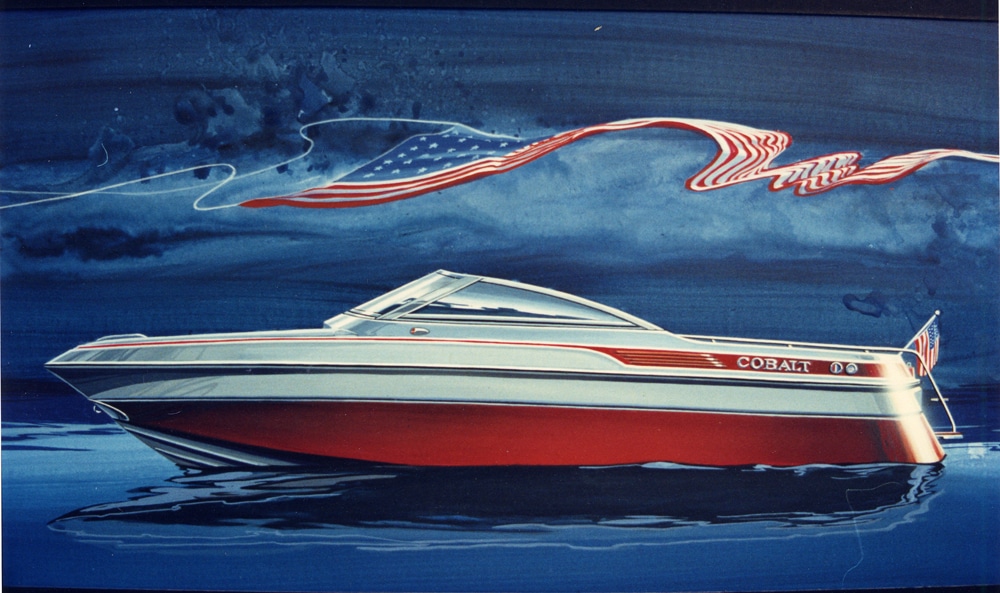
Check out some of the boat designs that inspired the models you own today.
What’s next?
How is the game going to change over the next 10 years? No one knows for sure, but if anyone is capable of making a good guess, it’s our five gurus. They reached a consensus on the following:
Efficiency
While all said there would be more experimenting with hybrid technology and fuel cells, many thought that the diesel engine would become dominant. Diesels are more economical to run, and if the demand increases, then the manufacturing costs — and ours as well — will go down.
Waterfront Access
There’s only so much waterfront suitable for marinas, and most of that is being taken over for housing and resorts. The alternative is to build floating island marinas/recreation centers using proven offshore oil-drilling-rig technology.
Dependability
We lose a large number of boaters each year to frustration over breakdowns and poor service. This will continue until boats become as reliable as other products and have the same backup service. This is, or should be, a priority mission.







